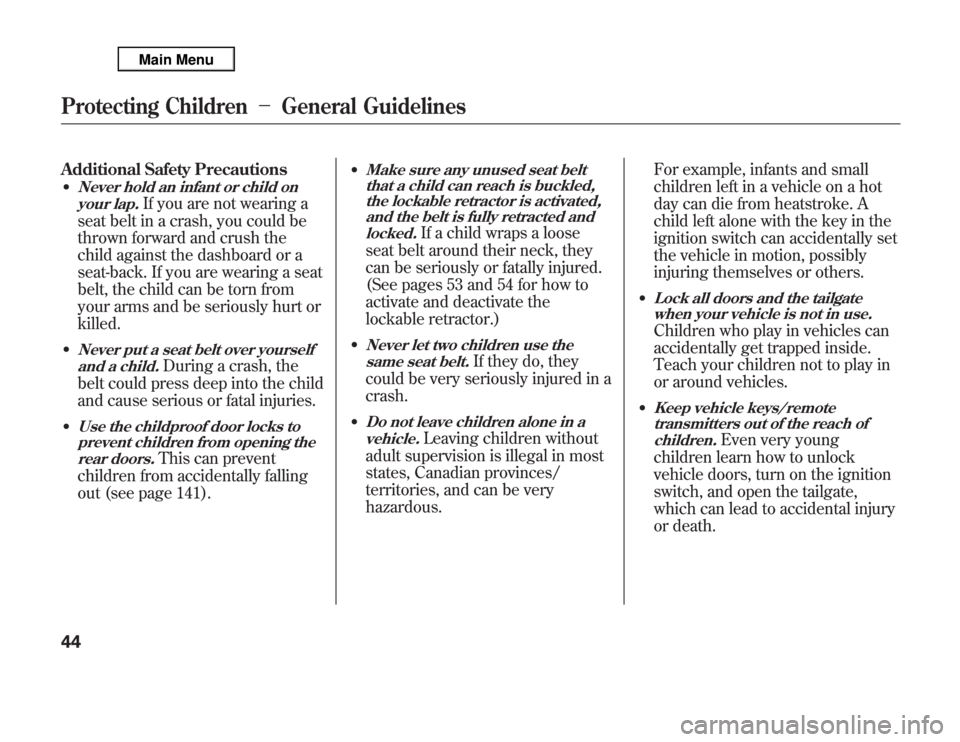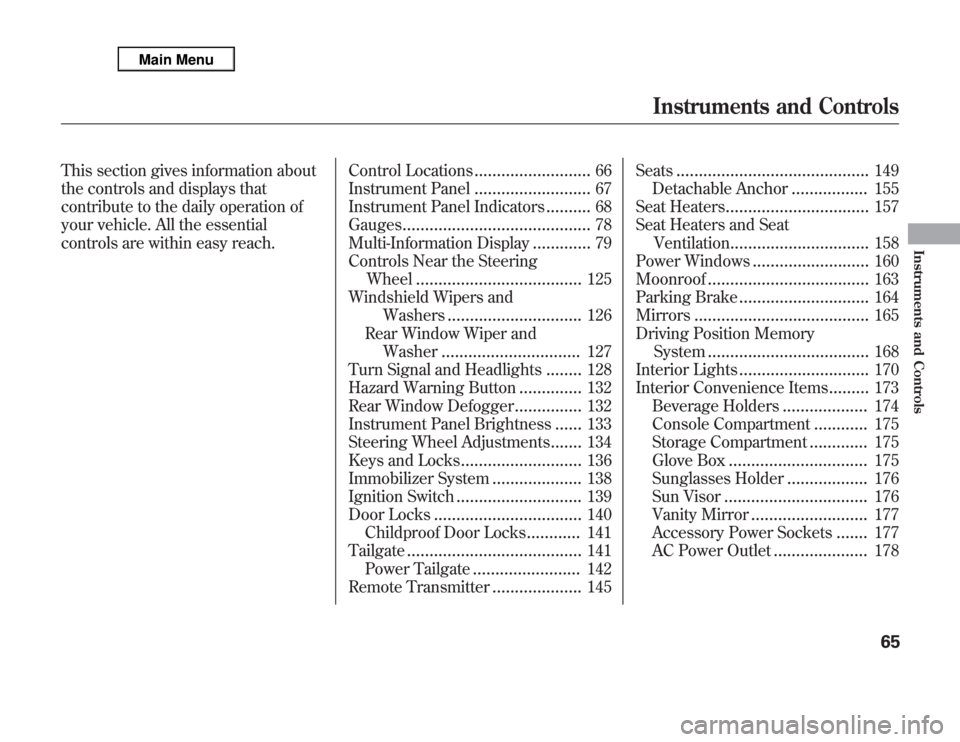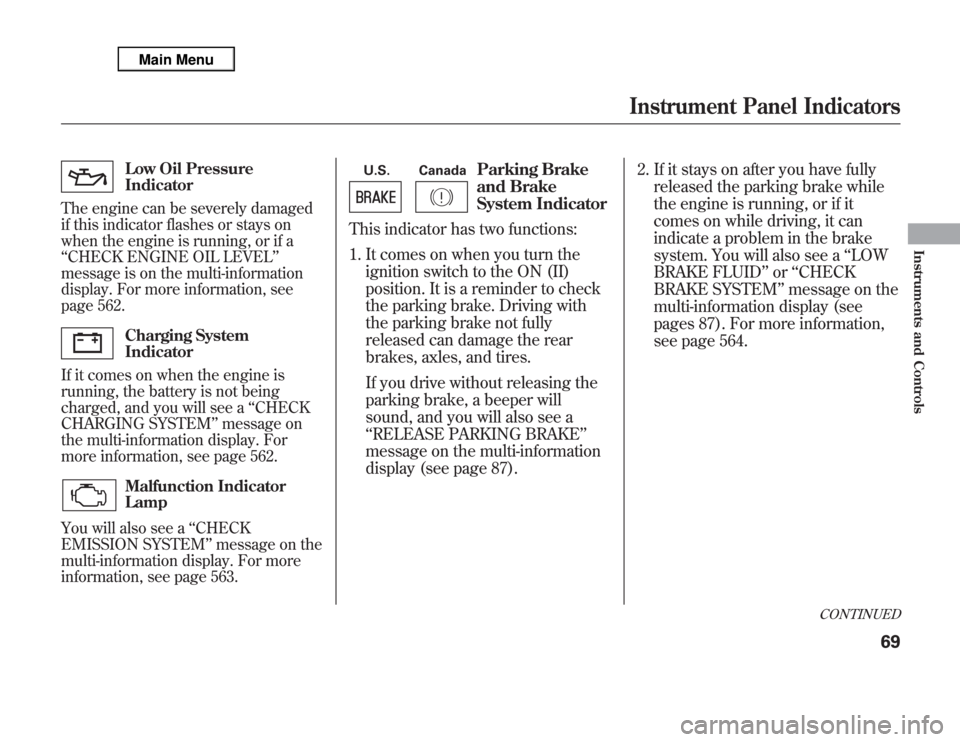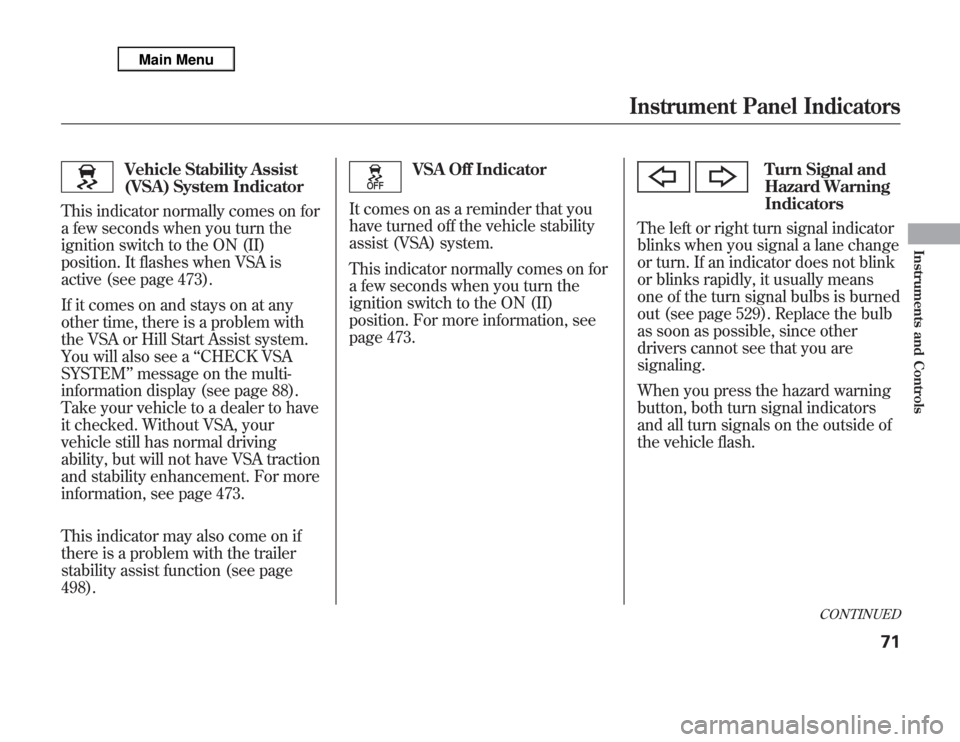ignition Acura MDX 2012 Owner's Manual
[x] Cancel search | Manufacturer: ACURA, Model Year: 2012, Model line: MDX, Model: Acura MDX 2012Pages: 621, PDF Size: 11.15 MB
Page 28 of 621

Seat Belt System Components
Your seat belt system includes lap/
shoulder belts in all seating
positions. The front seat belts are
also equipped with automatic seat
belt tensioners and, on models with
collision mitigation braking system™
(CMBS™), seat belt e-pretensioners.
The seat belt system
includes an indicator on the
instrument panel and a beeper to
remind you and your front passenger
to fasten your seat belts.
This system monitors the front seat
belts. If you turn the ignition switch
to the ON (II) position before your
seat belt is fastened, the beeper will
sound and the indicator will flash. If
your seat belt is not fastened before
the beeper stops, the indicator will
stop flashing but remain on.
If a front passenger does not fasten
their seat belt, the indicator will
come on about 6 seconds after the
ignition switch is turned to the ON
(II) position.If either the driver or a front
passenger does not fasten their seat
belt while driving, the beeper will
sound and the indicator will flash
again at regular intervals.
You will also see a‘‘FASTEN SEAT
BELT’’or‘‘FASTEN PASSENGER
SEAT BELT’’message on the multi-
information display (see page 87).
When no one is sitting in the front
passenger's seat, the indicator
should not come on and the beeper
should not sound. When an infant or
small child is riding there, the
indicator may not come on and the
beeper may not sound.
CONTINUED
Additional Information About Your Seat Belts
21
Driver and Passenger Safety
Page 36 of 621

●
Weight sensors that monitor the
weight on the front passenger's
seat. If the weight is about 65 lbs
(29 kg) or less (the weight of an
infant or small child), the
passenger's front airbag will be
turned off (see page 31).
●
A rollover sensor that can detect if
your vehicle is about to roll over
and signal the control unit to
deploy both side curtain airbags
(see page 35).
●
A sophisticated electronic system
that continually monitors and
records information about the
sensors, the control unit, the
airbag activators, the seat belt
tensioners, and driver and front
passenger seat belt use when the
ignition switch is in the ON (II)
position.
●
An indicator on the instrument
panel that alerts you to a possible
problem with your airbag system
components (see page 36 and 67).
●
An indicator on the instrument
panel that alerts you that the
passenger's side airbag has been
turned off (see page 36).
●
An indicator on the dashboard that
alerts you that the passenger's
front airbag has been turned off
(see page 37).
●
Emergency backup power in case
your vehicle's electrical system is
disconnected in a crash.
Additional Information About Your Airbags
29
Driver and Passenger Safety
Page 43 of 621

How the SRS Indicator Works
The SRS indicator alerts you
to a potential problem with
your airbag system components.
When you turn the ignition switch to
the ON (II) position, this indicator
comes on briefly then goes off. This
tells you the system is working
properly.
If the indicator comes on at any other
time, or does not come on at all, you
should have the system checked by
your dealer. For example:
●
If the SRS indicator does not come
on after you turn the ignition switch
to the ON (II) position.
●
If the indicator stays on after the
engine starts.
●
If the indicator comes on or flashes
on and off while you drive.You will also see a‘‘CHECK AIRBAG
SYSTEM’’message on the multi-
information display (see page 87).
If you see any of these indications,
the airbag system components may
not work properly when you need
them.
Ignoring the SRS indicator can
result in serious injury or death
if the airbag systems or
tensioners do not work
properly.
Have your vehicle checked by a
dealer as soon as possible if
the SRS indicator alerts you to
a possible problem.How the Side Airbag Off Indicator
Works
U.S. Canada
This indicator
alerts you that the
passenger's side airbag has been
automatically shut off. It does
not
mean there is a problem with your
side airbags.
When you turn the ignition switch to
the ON (II) position, the indicator
should come on briefly and then go
out (see page 70). If it does not come
on, stays on, or comes on while
driving without a passenger in the
front seat, you will also see a
‘‘PASSENGER SIDE AIRBAG OFF’’
message on the multi-information
display. Have the system checked
(see page 87).
Additional Information About Your Airbags36
Page 51 of 621

Additional Safety Precautions●
Never hold an infant or child on
your lap.
If you are not wearing a
seat belt in a crash, you could be
thrown forward and crush the
child against the dashboard or a
seat-back. If you are wearing a seat
belt, the child can be torn from
your arms and be seriously hurt or
killed.
●
Never put a seat belt over yourself
and a child.
During a crash, the
belt could press deep into the child
and cause serious or fatal injuries.
●
Use the childproof door locks to
prevent children from opening the
rear doors.
This can prevent
children from accidentally falling
out (see page 141).
●
Make sure any unused seat belt
that a child can reach is buckled,
the lockable retractor is activated,
and the belt is fully retracted and
locked.
If a child wraps a loose
seat belt around their neck, they
can be seriously or fatally injured.
(See pages 53 and 54 for how to
activate and deactivate the
lockable retractor.)
●
Never let two children use the
same seat belt.
If they do, they
could be very seriously injured in a
crash.
●
Do not leave children alone in a
vehicle.
Leaving children without
adult supervision is illegal in most
states, Canadian provinces/
territories, and can be very
hazardous.For example, infants and small
children left in a vehicle on a hot
day can die from heatstroke. A
child left alone with the key in the
ignition switch can accidentally set
the vehicle in motion, possibly
injuring themselves or others.
●
Lock all doors and the tailgate
when your vehicle is not in use.Children who play in vehicles can
accidentally get trapped inside.
Teach your children not to play in
or around vehicles.
●
Keep vehicle keys/remote
transmitters out of the reach of
children.
Even very young
children learn how to unlock
vehicle doors, turn on the ignition
switch, and open the tailgate,
which can lead to accidental injury
or death.
Protecting Children-General Guidelines44
Page 72 of 621

This section gives information about
the controls and displays that
contribute to the daily operation of
your vehicle. All the essential
controls are within easy reach.Control Locations
..........................
66
Instrument Panel
..........................
67
Instrument Panel Indicators
..........
68
Gauges
..........................................
78
Multi-Information Display
.............
79
Controls Near the Steering
Wheel
.....................................
125
Windshield Wipers and
Washers
..............................
126
Rear Window Wiper and
Washer
...............................
127
Turn Signal and Headlights
........
128
Hazard Warning Button
..............
132
Rear Window Defogger
...............
132
Instrument Panel Brightness
......
133
Steering Wheel Adjustments
.......
134
Keys and Locks
...........................
136
Immobilizer System
....................
138
Ignition Switch
............................
139
Door Locks
.................................
140
Childproof Door Locks
............
141
Tailgate
.......................................
141
Power Tailgate
........................
142
Remote Transmitter
....................
145Seats
...........................................
149
Detachable Anchor
.................
155
Seat Heaters
................................
157
Seat Heaters and Seat
Ventilation
...............................
158
Power Windows
..........................
160
Moonroof
....................................
163
Parking Brake
.............................
164
Mirrors
.......................................
165
Driving Position Memory
System
....................................
168
Interior Lights
.............................
170
Interior Convenience Items
.........
173
Beverage Holders
...................
174
Console Compartment
............
175
Storage Compartment
.............
175
Glove Box
...............................
175
Sunglasses Holder
..................
176
Sun Visor
................................
176
Vanity Mirror
..........................
177
Accessory Power Sockets
.......
177
AC Power Outlet
.....................
178
Instruments and Controls
65
Instruments and Controls
Page 75 of 621

The instrument panel has many
indicators to give you important
information about your vehicle.
Seat Belt Reminder
Indicator
This indicator comes on when you
turn the ignition switch to the ON
(II) position. It reminds you and your
passengers to fasten your seat belts.
A beeper also sounds if you have not
fastened your seat belt.
If you turn the ignition switch to the
ON (II) position before fastening
your seat belts, the beeper sounds,
and the indicator flashes. If you do
not fasten your seat belts before the
beeper stops, the indicator stops
flashing but remains on.
If your front passenger does not
fasten their seat belt, the indicator
comes on about 6 seconds after the
ignition switch is turned to the ON
(II) position.If either of you do not fasten your
seat belt while driving, the beeper
will sound and the indicator will flash
again at regular intervals, and you
will see a‘‘FASTEN SEAT BELT’’or
‘‘FASTEN PASSENGER SEAT
BELT’’message on the multi-
information display (see page 87).
For more information, see page 21.
Instrument Panel Indicators68
Page 76 of 621

Low Oil Pressure
Indicator
The engine can be severely damaged
if this indicator flashes or stays on
when the engine is running, or if a
‘‘CHECK ENGINE OIL LEVEL’’
message is on the multi-information
display. For more information, see
page 562.Charging System
Indicator
If it comes on when the engine is
running, the battery is not being
charged, and you will see a‘‘CHECK
CHARGING SYSTEM’’message on
the multi-information display. For
more information, see page 562.Malfunction Indicator
Lamp
You will also see a‘‘CHECK
EMISSION SYSTEM’’message on the
multi-information display. For more
information, see page 563.
U.S. Canada
Parking Brake
and Brake
System Indicator
This indicator has two functions:
1. It comes on when you turn the
ignition switch to the ON (II)
position. It is a reminder to check
the parking brake. Driving with
the parking brake not fully
released can damage the rear
brakes, axles, and tires.
If you drive without releasing the
parking brake, a beeper will
sound, and you will also see a
‘‘RELEASE PARKING BRAKE’’
message on the multi-information
display (see page 87).2. If it stays on after you have fully
released the parking brake while
the engine is running, or if it
comes on while driving, it can
indicate a problem in the brake
system. You will also see a‘‘LOW
BRAKE FLUID’’or‘‘CHECK
BRAKE SYSTEM’’message on the
multi-information display (see
pages 87). For more information,
see page 564.
CONTINUED
Instrument Panel Indicators
69
Instruments and Controls
Page 77 of 621

Supplemental Restraint
System Indicator
This indicator comes on briefly when
you turn the ignition switch to the
ON (II) position. If it comes on at any
other time, it indicates a potential
problem with your front airbags. This
indicator will also alert you to a
potential problem with your airbag
system components. You will also
see a‘‘CHECK AIRBAG SYSTEM’’
message on the multi-information
display (see page 87). For more
information, see page 36.
U.S. Canada
Side Airbag Off
Indicator
This indicator comes on when you
turn the ignition switch to the ON
(II) position. If it comes on at any
other time, it indicates that the
passenger's side airbag has
automatically shut off. You will also
see a‘‘PASSENGER SIDE AIRBAG
OFF’’message on the multi-
information display (see page 87).
For more information, see page 36.
Anti-lock Brake System
(ABS) Indicator
This indicator normally comes on for
a few seconds when you turn the
ignition switch to the ON (II)
position. If this indicator comes on at
any other time, there is a problem in
the ABS. If this happens, take the
vehicle to your dealer to have it
checked. With this indicator on, your
vehicle still has normal braking
ability but no anti-lock function. You
will also see a‘‘CHECK ABS
SYSTEM’’message on the multi-
information display (see page 88).
For more information, see page 461.
Instrument Panel Indicators70
Page 78 of 621

Vehicle Stability Assist
(VSA) System Indicator
This indicator normally comes on for
a few seconds when you turn the
ignition switch to the ON (II)
position. It flashes when VSA is
active (see page 473).
If it comes on and stays on at any
other time, there is a problem with
the VSA or Hill Start Assist system.
You will also see a‘‘CHECK VSA
SYSTEM’’message on the multi-
information display (see page 88).
Take your vehicle to a dealer to have
it checked. Without VSA, your
vehicle still has normal driving
ability, but will not have VSA traction
and stability enhancement. For more
information, see page 473.
This indicator may also come on if
there is a problem with the trailer
stability assist function (see page
498).
VSA Off Indicator
It comes on as a reminder that you
have turned off the vehicle stability
assist (VSA) system.
This indicator normally comes on for
a few seconds when you turn the
ignition switch to the ON (II)
position. For more information, see
page 473.
Turn Signal and
Hazard Warning
Indicators
The left or right turn signal indicator
blinks when you signal a lane change
or turn. If an indicator does not blink
or blinks rapidly, it usually means
one of the turn signal bulbs is burned
out (see page 529). Replace the bulb
as soon as possible, since other
drivers cannot see that you are
signaling.
When you press the hazard warning
button, both turn signal indicators
and all turn signals on the outside of
the vehicle flash.
CONTINUED
Instrument Panel Indicators
71
Instruments and Controls
Page 79 of 621

Low Tire Pressure/
TPMS Indicator
This indicator normally comes on for
a few seconds when you turn the
ignition switch to the ON (II)
position.
This indicator has two functions:
1. If it comes on while driving, it
indicates that one or more of your
vehicle's tires are significantly low
on pressure.
You will also see a‘‘CHECK TIRE
PRESSURE’’message on the multi-
information display (see page 88).
Check the tire pressure monitor on
the multi-information display and
determine the cause (see page 456).If this happens, pull to the side of the
road when it is safe, check which tire
has lost pressure on the multi-
information display, and determine
the cause. If it is because of a flat tire,
have the flat tire repaired as soon as
possible. If two or more tires are
underinflated, call a professional
towing service. For more
information, see page 572.
2. If this indicator begins to flash,
there is a problem with the tire
pressure monitoring system
(TPMS). You will also see a
‘‘CHECK TPMS SYSTEM’’
message on the multi-information
display. The indicator continues to
flash for a while (approximately 1
minute), then stays on. If this
happens, have your dealer check
the system as soon as possible.
For more information, see page
458.
A/T Temperature
Indicator
This indicator monitors the
temperature of the automatic
transmission fluid. It should come on
for a few seconds when you turn the
ignition switch to the ON (II)
position. If it comes on while driving,
it means the transmission fluid
temperature is too high. Pull to the
side of the road when it is safe, shift
to Park, and let the engine idle until
the indicator goes out.
You will also see an‘‘A/T TEMP
HIGH’’message on the multi-
information display (see page 88).
Continuing to drive with the A/T
temperature indicator on may cause
serious damage to the transmission.
Instrument Panel Indicators72